What is FilesLocker Ransomware virus
FilesLocker Ransomware is regarded as a severe infection, generally known as ransomware or file-encrypting malware. If you have never encountered this type of malicious software until now, you are in for a shock. If a strong encryption algorithm was used to encrypt your files, they’ll be locked, which means you won’t be able to access them. This is considered to be a very dangerous threat because it’s not always possible to decrypt files. 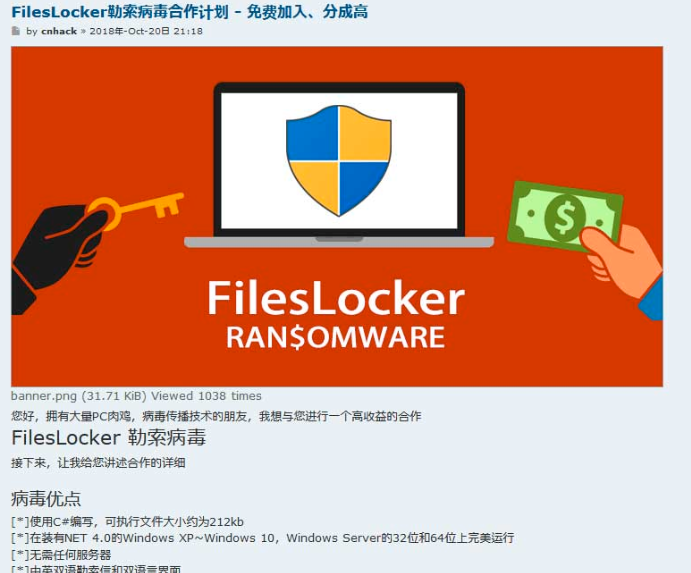
You do have the option of paying the ransom but that isn’t exactly the option malware researchers suggest. First of all, paying will not ensure that files are decrypted. What is stopping crooks from just taking your money, without giving you a way to decrypt files. The cyber crooks’ future activities would also be supported by that money. Would you really want to support something that does billions of dollars in damage. And the more people give into the demands, the more profitable data encoding malware gets, and that kind of money is sure to lure in various crooks. You might end up in this type of situation again, so investing the demanded money into backup would be better because you would not need to worry about your data. In case you had backup prior to contamination, remove FilesLocker Ransomware virus and proceed to data recovery. If you haven’t come across ransomware before, it is also possible you don’t know how it managed to infect your system, which is why you should vigilantly read the below paragraph.
FilesLocker Ransomware distribution methods
Most frequent data encoding malware spread ways are via spam emails, exploit kits and malicious downloads. Seeing as these methods are still quite popular, that means that people are somewhat careless when they use email and download files. More elaborate methods could be used as well, although they aren’t as popular. Cyber crooks add a malicious file to an email, write some type of text, and pretend to be from a legitimate company/organization. Because the topic is delicate, people are more prone to opening emails discussing money, thus those types of topics can commonly be encountered. Commonly, criminals pretend to be from Amazon, with the email warning you that there was suspicious activity in your account or some kind of purchase was made. You have to look out for certain signs when opening emails if you want an infection-free system. See if the sender is familiar to you before opening the file attached to the email, and if they aren’t familiar to you, look into them carefully. Checking the sender’s email address is still essential, even if you are familiar with the sender. The emails also commonly contain grammar mistakes, which tend to be pretty easy to see. You should also take note of how the sender addresses you, if it’s a sender who knows your name, they’ll always greet you by your name, instead of a universal Customer or Member. Unpatched software vulnerabilities might also be used for infection. Those weak spots are normally found by malware researchers, and when software makers become aware of them, they release updates so that malicious software developers can’t take advantage of them to corrupt devices with malicious programs. As has been proven by WannaCry, however, not everyone rushes to install those updates. Because a lot of malicious software can use those vulnerabilities it’s critical that your software regularly get patches. If you find the alerts about updates annoying, you could set them up to install automatically.
What can you do about your files
Your files will be encrypted by ransomware as soon as it infects your device. You may not notice initially but when your files can’t be as normal, it’ll become obvious that something is going on. You’ll see that all affected files have weird extensions attached to them, and that helps people recognize what kind of data encrypting malicious software it is. Sadly, it may not be possible to decode files if the ransomware used powerful encryption algorithms. After all files have been locked, you’ll find a ransom notification, which ought to explain, to some extent, what has happened and how you ought to proceed. What cyber criminals will encourage you do is use their paid decryptor, and threaten that other methods could result in damage to your files. The note should plainly explain how much the decryption utility costs but if it doesn’t, you will be proposed a way to contact the crooks to set up a price. As you’ve probably guessed, paying isn’t the option we would suggest. Only think about paying when everything else isn’t successful. Try to remember whether you recently made copies of files but forgotten. It is also possible a free decryption utility has been released. A decryption utility might be available for free, if someone was able to crack the file encoding malware. Take that into consideration before paying the requested money even crosses your mind. Using that money for a reliable backup might do more good. If backup is available, you can unlock FilesLocker Ransomware files after you uninstall FilesLocker Ransomware virus completely. If you are now familiar with ransomware, you ought to be able to shield your device from data encoding malware. At the very least, stop opening email attachments randomly, update your programs, and only download from sources you know to be secure.
Ways to delete FilesLocker Ransomware
It would be a better idea to download a malware removal utility because it’ll be necessary to get rid of the ransomware if it is still in your computer. To manually fix FilesLocker Ransomware virus isn’t an easy process and might lead to additional damage to your computer. Thus, choose the automatic way. The tool isn’t only capable of helping you deal with the infection, but it might stop future data encrypting malware from entering. Pick the anti-malware tool that best suits what you need, and allow it to scan your system for the threat once you install it. Keep in mind that, a malware removal program unlock FilesLocker Ransomware files. After the file encrypting malicious software is entirely eliminated, it’s safe to use your system again.
Offers
Download Removal Toolto scan for FilesLocker RansomwareUse our recommended removal tool to scan for FilesLocker Ransomware. Trial version of provides detection of computer threats like FilesLocker Ransomware and assists in its removal for FREE. You can delete detected registry entries, files and processes yourself or purchase a full version.
More information about SpyWarrior and Uninstall Instructions. Please review SpyWarrior EULA and Privacy Policy. SpyWarrior scanner is free. If it detects a malware, purchase its full version to remove it.

WiperSoft Review Details WiperSoft (www.wipersoft.com) is a security tool that provides real-time security from potential threats. Nowadays, many users tend to download free software from the Intern ...
Download|more


Is MacKeeper a virus? MacKeeper is not a virus, nor is it a scam. While there are various opinions about the program on the Internet, a lot of the people who so notoriously hate the program have neve ...
Download|more


While the creators of MalwareBytes anti-malware have not been in this business for long time, they make up for it with their enthusiastic approach. Statistic from such websites like CNET shows that th ...
Download|more
Quick Menu
Step 1. Delete FilesLocker Ransomware using Safe Mode with Networking.
Remove FilesLocker Ransomware from Windows 7/Windows Vista/Windows XP
- Click on Start and select Shutdown.
- Choose Restart and click OK.

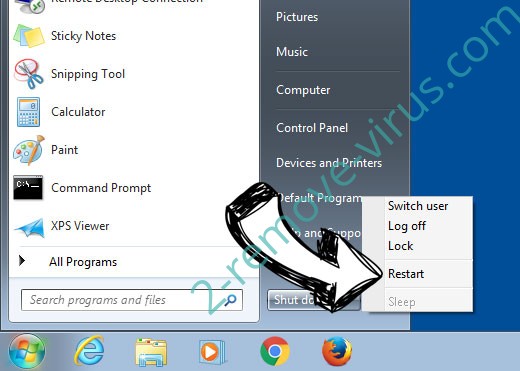
- Start tapping F8 when your PC starts loading.
- Under Advanced Boot Options, choose Safe Mode with Networking.

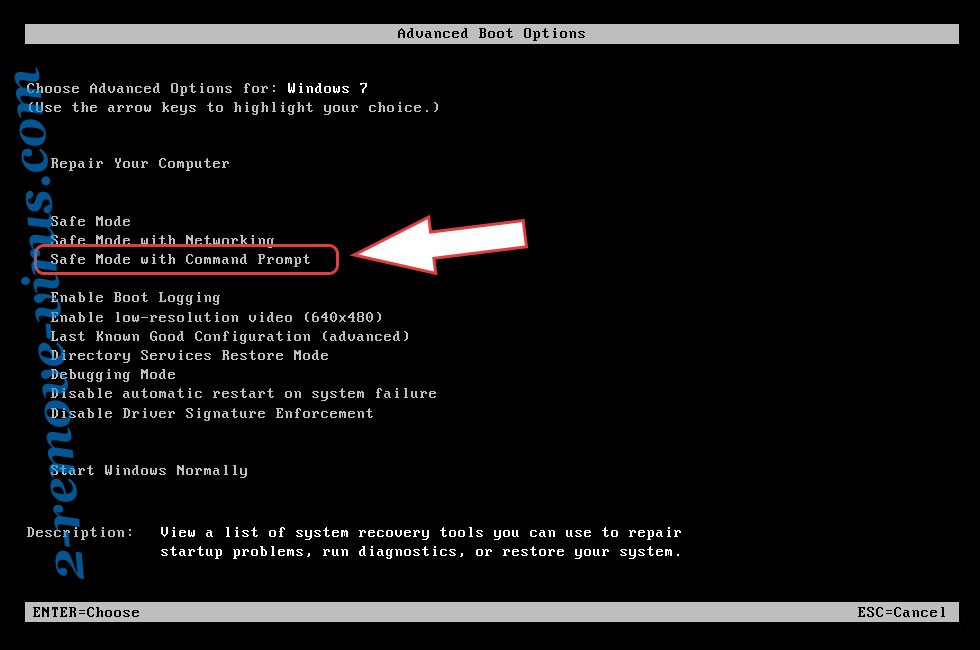
- Open your browser and download the anti-malware utility.
- Use the utility to remove FilesLocker Ransomware
Remove FilesLocker Ransomware from Windows 8/Windows 10
- On the Windows login screen, press the Power button.
- Tap and hold Shift and select Restart.

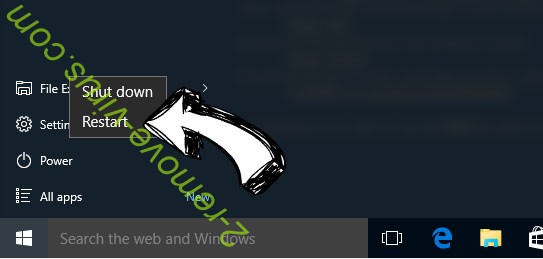
- Go to Troubleshoot → Advanced options → Start Settings.
- Choose Enable Safe Mode or Safe Mode with Networking under Startup Settings.

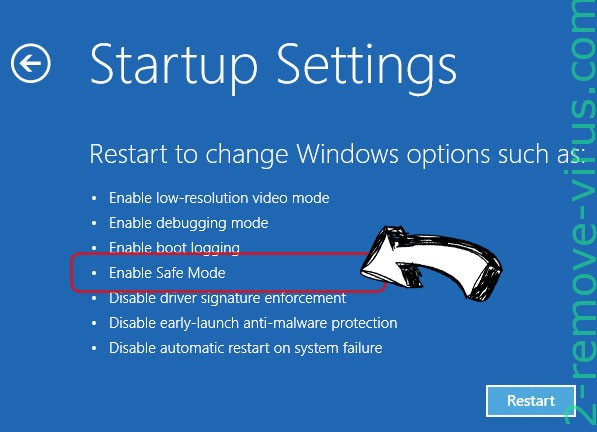
- Click Restart.
- Open your web browser and download the malware remover.
- Use the software to delete FilesLocker Ransomware
Step 2. Restore Your Files using System Restore
Delete FilesLocker Ransomware from Windows 7/Windows Vista/Windows XP
- Click Start and choose Shutdown.
- Select Restart and OK


- When your PC starts loading, press F8 repeatedly to open Advanced Boot Options
- Choose Command Prompt from the list.

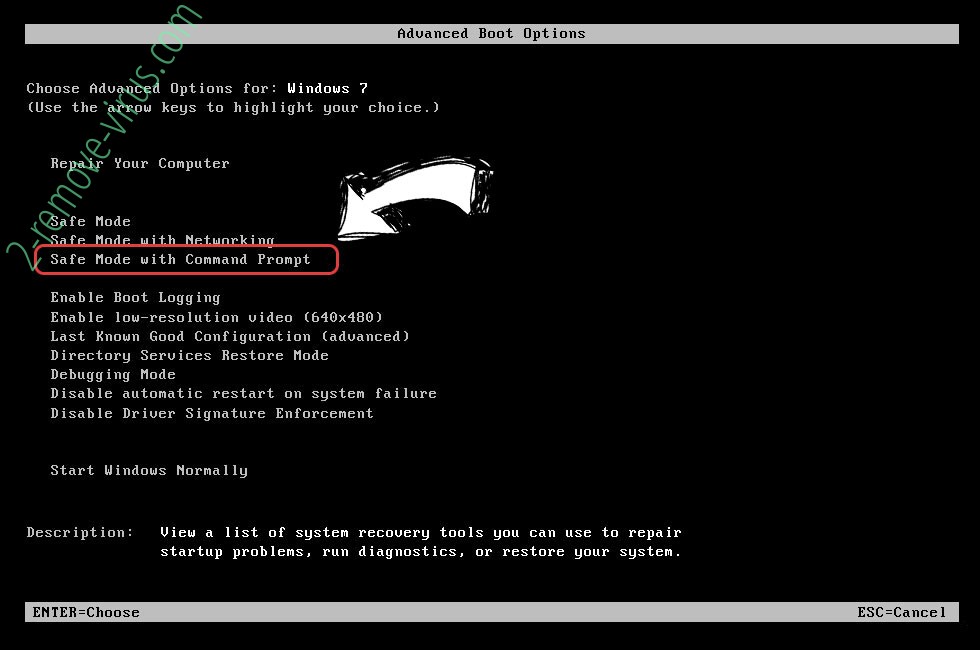
- Type in cd restore and tap Enter.

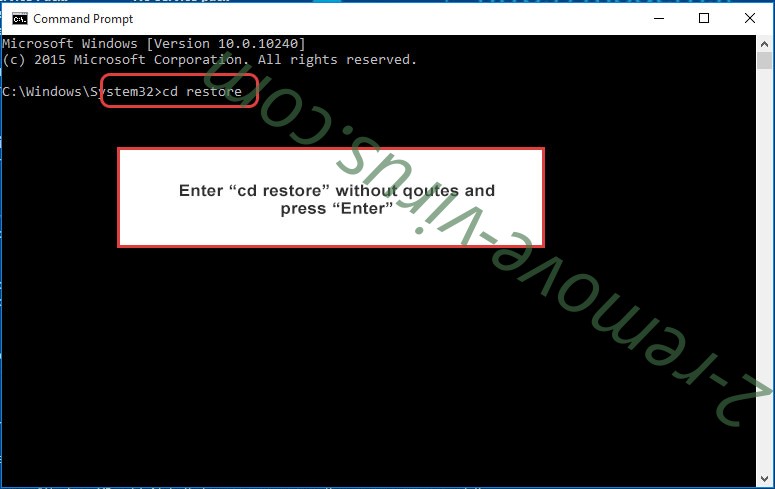
- Type in rstrui.exe and press Enter.

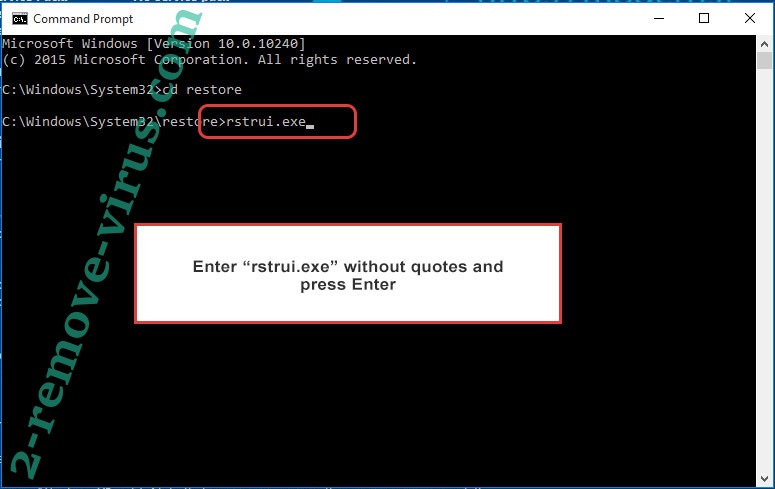
- Click Next in the new window and select the restore point prior to the infection.

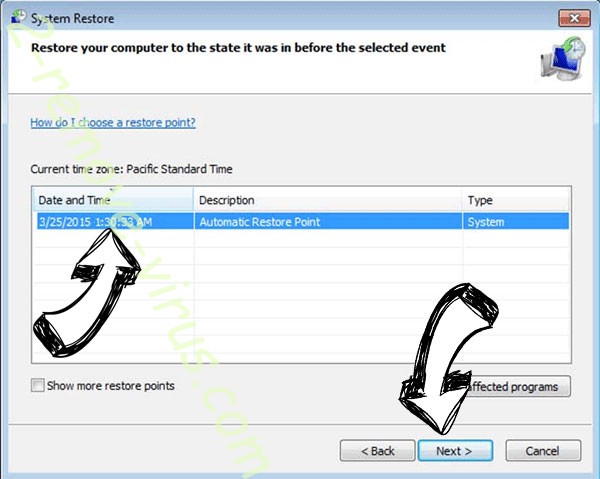
- Click Next again and click Yes to begin the system restore.

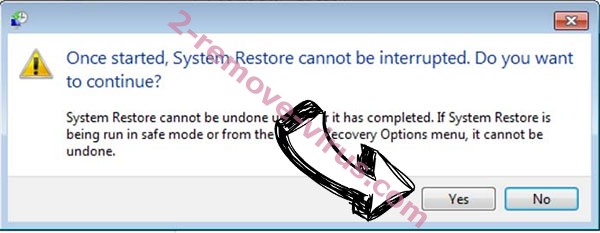
Delete FilesLocker Ransomware from Windows 8/Windows 10
- Click the Power button on the Windows login screen.
- Press and hold Shift and click Restart.


- Choose Troubleshoot and go to Advanced options.
- Select Command Prompt and click Restart.

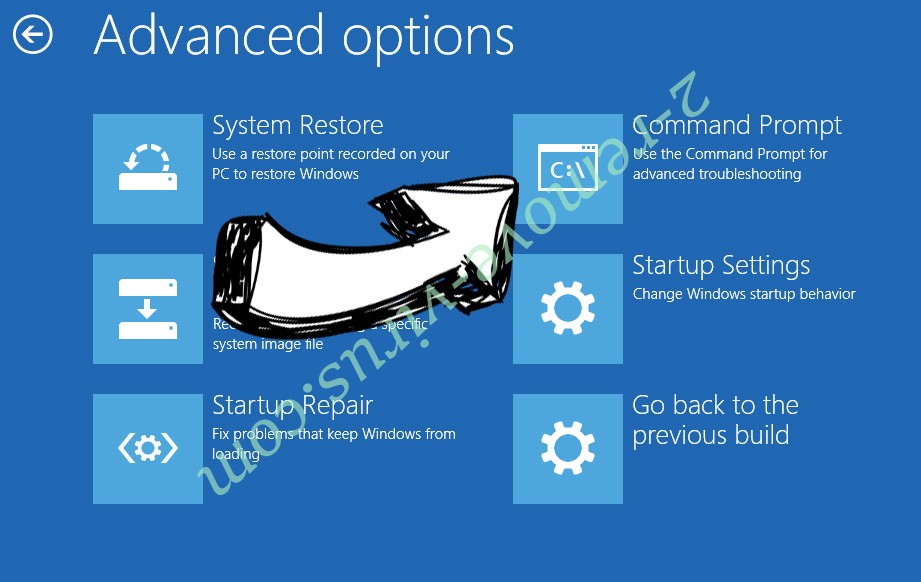
- In Command Prompt, input cd restore and tap Enter.


- Type in rstrui.exe and tap Enter again.


- Click Next in the new System Restore window.

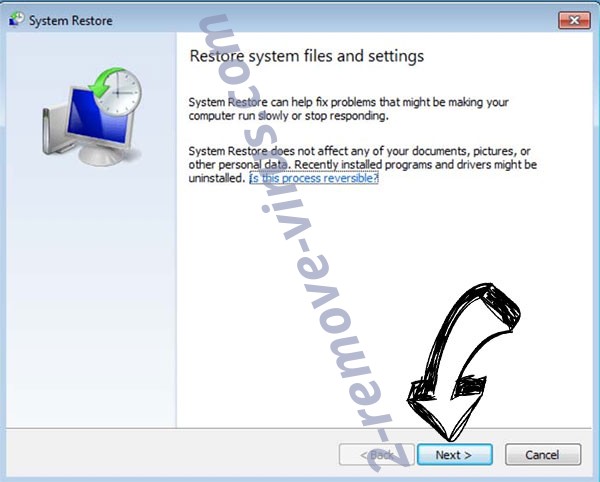
- Choose the restore point prior to the infection.


- Click Next and then click Yes to restore your system.


Site Disclaimer
2-remove-virus.com is not sponsored, owned, affiliated, or linked to malware developers or distributors that are referenced in this article. The article does not promote or endorse any type of malware. We aim at providing useful information that will help computer users to detect and eliminate the unwanted malicious programs from their computers. This can be done manually by following the instructions presented in the article or automatically by implementing the suggested anti-malware tools.
The article is only meant to be used for educational purposes. If you follow the instructions given in the article, you agree to be contracted by the disclaimer. We do not guarantee that the artcile will present you with a solution that removes the malign threats completely. Malware changes constantly, which is why, in some cases, it may be difficult to clean the computer fully by using only the manual removal instructions.
